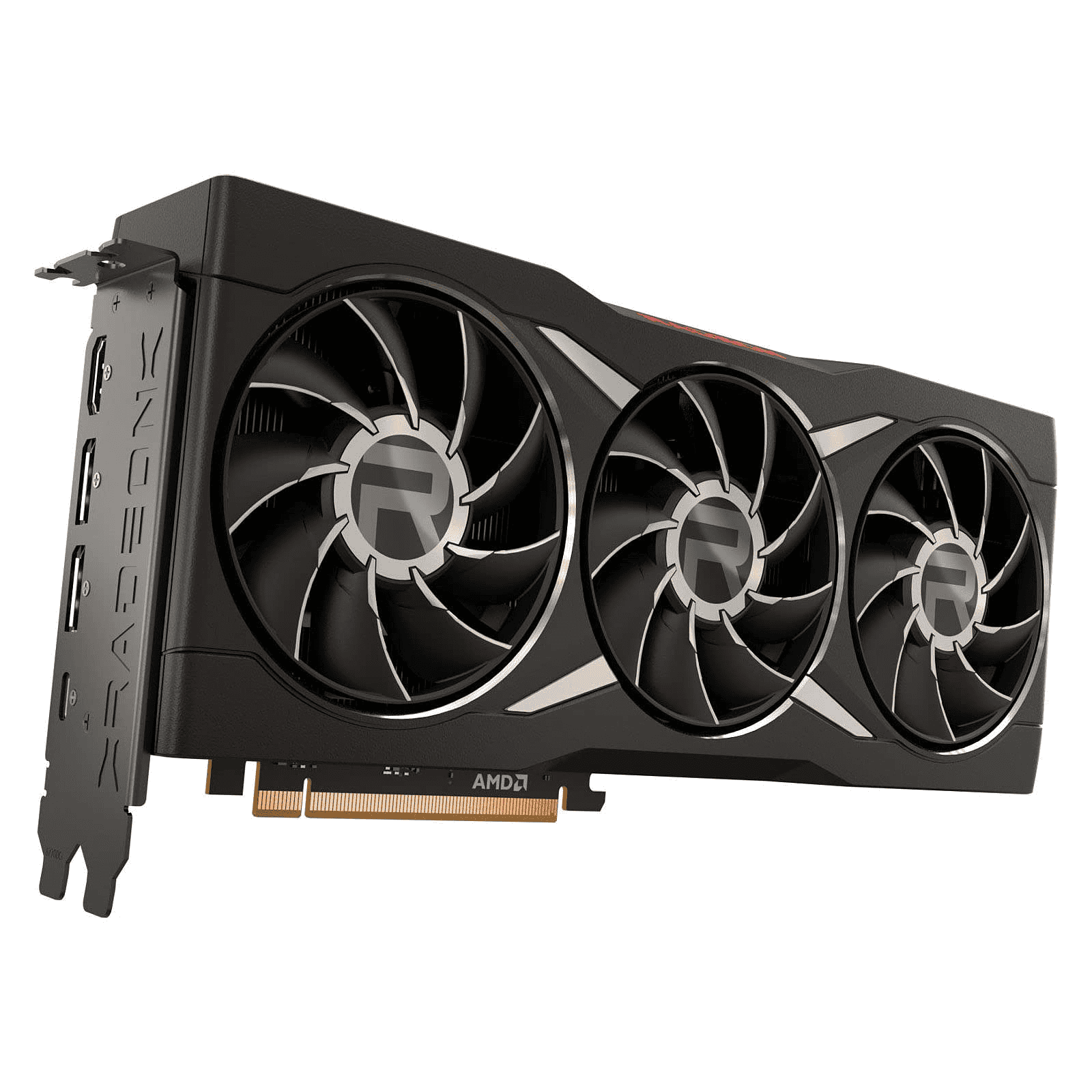The AMD RX 6950 XT and NVIDIA GeForce RTX 4070 are top contenders in the graphics card market. These GPUs offer high-end performance for gamers and content creators alike. Based on user benchmarks, the RTX 4070 slightly edges out the RX 6950 XT in overall effective speed.
When choosing between these cards, you’ll want to consider factors beyond raw performance. The RTX 4070 boasts NVIDIA’s latest architecture, including improved ray tracing and DLSS 3 technology. AMD’s RX 6950 XT, while slightly older, often comes at a more competitive price point and excels in traditional rasterization.
Your decision may hinge on specific use cases. For 1440p gaming, both cards deliver excellent frame rates. At 4K resolution, the RX 6950 XT sometimes pulls ahead, especially in titles optimized for AMD hardware. Consider your monitor, preferred games, and budget when making your choice.
| Feature | RX 6950 XT | RTX 4070 |
|---|---|---|
| VRAM | 16GB GDDR6 | 12GB GDDR6X |
| Ray Tracing | Yes | Yes (Better) |
| MSRP | $1099 | $599 |
| Power Draw | 335W | 200W |

A Head-to-Head Comparison of Graphics Cards
Raw Performance Comparison
The AMD RX 6950 XT and the NVIDIA RTX 4070 compete in a similar performance bracket, although they have different strengths. In raw rasterization performance (traditional rendering without ray tracing), the RX 6950 XT generally holds a slight edge, especially at higher resolutions like 1440p and 4K. This means it can deliver higher frame rates in many games without ray tracing enabled.
Ray Tracing and DLSS/FSR
When it comes to ray tracing, NVIDIA’s RTX 4070 has a clear advantage. Its dedicated ray tracing cores provide better performance in games that utilize this technology. Furthermore, the RTX 4070 benefits from NVIDIA’s DLSS 3 (Deep Learning Super Sampling) technology, which uses AI to upscale lower-resolution images to higher resolutions, improving performance while maintaining good image quality. AMD’s FSR (FidelityFX Super Resolution) is a comparable upscaling technology, but DLSS 3 generally offers better image quality and performance gains in supported titles.
VRAM and Memory Bandwidth
The RX 6950 XT features 16GB of GDDR6 memory, while the RTX 4070 has 12GB of GDDR6X. While the 6950 XT has more VRAM, the 4070’s GDDR6X memory offers higher bandwidth. In most current games, 12GB is sufficient, but the extra VRAM on the 6950 XT could be beneficial in future games or for users working with large textures in content creation applications.
Power Consumption and Efficiency
The RTX 4070 generally has lower power consumption than the RX 6950 XT. This translates to lower operating temperatures and potentially quieter cooling solutions. This could make the 4070 an attractive option for those concerned about power bills or building a quieter PC.
Pricing and Value
Pricing is a crucial factor. The relative value of these cards depends on their current market prices. If the RX 6950 XT is significantly cheaper than the RTX 4070, its raw performance advantage might make it the better value. However, if the prices are similar, the RTX 4070’s ray tracing performance and DLSS 3 support could make it a more compelling choice for many gamers.
Key Differences Between the RX 6950 XT and RTX 4070
| Feature | AMD RX 6950 XT | NVIDIA RTX 4070 |
|---|---|---|
| Rasterization Performance | Generally higher | Slightly lower |
| Ray Tracing Performance | Lower | Higher |
| Upscaling Technology | FSR | DLSS 3 |
| VRAM | 16GB GDDR6 | 12GB GDDR6X |
| Power Consumption | Higher | Lower |
GPU Architecture and Technology
Choosing the right graphics card can significantly impact your gaming experience and overall PC performance. Two popular options that often find themselves in direct competition are the AMD RX 6950 XT and the NVIDIA RTX 4070. Both offer strong performance, but they cater to slightly different needs and priorities.
The NVIDIA RTX 4070 and Radeon RX 6950 XT represent different approaches to GPU design. Their architectures impact performance in gaming, ray tracing, and AI tasks.
GPU Architectural Overview
The RTX 4070 uses NVIDIA’s Ada Lovelace architecture. It packs more transistors into a smaller die size than its predecessor. This leads to better power efficiency and performance per watt.
The RX 6950 XT is based on AMD’s RDNA 2 architecture. It focuses on high clock speeds and large amounts of cache memory. This design helps boost gaming performance at high resolutions.
Key differences:
- RTX 4070: 5nm process, 35.8 billion transistors
- RX 6950 XT: 7nm process, 26.8 billion transistors
The newer process node gives the RTX 4070 an edge in efficiency. But the RX 6950 XT makes up for it with higher clock speeds and more compute units.
Advancements in Ray Tracing Capabilities
Ray tracing creates more realistic lighting, shadows, and reflections in games. Both GPUs support hardware-accelerated ray tracing, but their approaches differ.
The RTX 4070 has dedicated RT cores. These allow for faster ray tracing calculations. It also features improved denoising algorithms to clean up the final image.
AMD’s RX 6950 XT uses ray accelerators built into its compute units. While effective, this method is generally slower than NVIDIA’s approach.
In most ray-traced games, you’ll see better performance from the RTX 4070. But the gap narrows at higher resolutions where the RX 6950 XT’s raw power comes into play.
AI Enhancements and DLSS
AI tech plays a big role in modern GPUs. It helps improve image quality and boost frame rates.
NVIDIA’s DLSS (Deep Learning Super Sampling) is a standout feature of the RTX 4070. It uses AI to upscale lower resolution images, increasing performance with minimal quality loss. The latest DLSS 3 adds frame generation for even higher frame rates.
AMD’s answer is FSR (FidelityFX Super Resolution). While not AI-based, it still offers upscaling benefits. The RX 6950 XT supports FSR 2.0, which improves upon the original algorithm.
| Feature | RTX 4070 | RX 6950 XT |
|---|---|---|
| AI Cores | Yes (Tensor) | No |
| Upscaling | DLSS 3 | FSR 2.0 |
| Frame Generation | Yes | No |
The RTX 4070’s AI capabilities give it an edge in supported games. But FSR works on a wider range of GPUs, including the RX 6950 XT.
Performance Metrics and Gaming Benchmarks
The RTX 4070 and RX 6950 XT offer impressive performance across various resolutions and games. Their capabilities shine in different scenarios, with each GPU excelling in specific areas.
Benchmarking Resolutions: 1080p, 1440p, and 4K
At 1080p, both GPUs deliver exceptional frame rates. The RTX 4070 often edges out the RX 6950 XT in this resolution. As you move to 1440p, the gap narrows. The RX 6950 XT starts to show its strength here, matching or slightly surpassing the RTX 4070 in some titles.
4K gaming is where these GPUs truly flex their muscles. The RX 6950 XT, with its larger VRAM, tends to perform better in memory-intensive 4K scenarios. However, the RTX 4070’s advanced features like DLSS can boost its 4K performance significantly in supported games.
| Resolution | RTX 4070 | RX 6950 XT |
|---|---|---|
| 1080p | Excellent | Very Good |
| 1440p | Great | Excellent |
| 4K | Good | Very Good |
Frame Rate Analysis in AAA Titles
In popular AAA games, both GPUs deliver solid performance. Cyberpunk 2077 runs smoothly on both cards, with the RTX 4070 having an edge due to its ray tracing capabilities and DLSS support.
Horizon Zero Dawn sees similar performance from both GPUs at 1440p. The RX 6950 XT pulls ahead slightly at 4K due to its larger VRAM.
Red Dead Redemption 2 favors the RX 6950 XT, especially at higher resolutions. You’ll see better frame rates with AMD’s offering in this title.
Memory Performance and Bandwidth
The RX 6950 XT boasts 16GB of GDDR6 memory, while the RTX 4070 has 12GB of GDDR6X. This gives the AMD card an advantage in memory-intensive scenarios, particularly at 4K resolution.
Memory clock speeds favor the RTX 4070, with its GDDR6X running at higher frequencies. This partially offsets its narrower memory bus width.
Bandwidth is crucial for high-resolution gaming. The RX 6950 XT’s wider memory bus helps it maintain strong performance at 4K, where memory demands are highest.
Pricing and Market Position
The NVIDIA GeForce RTX 4070 and AMD Radeon RX 6950 XT occupy different price points and market segments. Their positioning affects consumer choices and availability.
Price-to-Performance Comparison
The RTX 4070 launched with an MSRP of $599, while the RX 6950 XT debuted at $1099. Despite the price gap, both GPUs offer competitive performance in their respective tiers. The RTX 4070 provides better power efficiency, using up to 74% less power per frame than the RX 6950 XT.
For 4K gaming, the RX 6950 XT often outperforms the RTX 4070. However, the RTX 4070 excels in ray tracing and DLSS-supported titles. This makes the RTX 4070 a strong contender for its price point.
| GPU | MSRP | Performance Tier |
|---|---|---|
| RTX 4070 | $599 | High-end |
| RX 6950 XT | $1099 | Enthusiast |
Consumer Demand and Availability
The RTX 4070 has seen steady demand since its release due to its balance of performance and price. It’s often considered one of the best graphics cards for high-end 1440p gaming. Availability has improved over time, with various models from different manufacturers readily accessible.
The RX 6950 XT, being an older model, has experienced price drops since launch. This has increased its appeal to buyers seeking top-tier AMD performance at a reduced cost. You can often find it discounted below its original MSRP, making it an attractive option for those who don’t require the latest architecture.
Frequently Asked Questions
The Radeon RX 6950 XT and RTX 4070 differ in gaming performance, power efficiency, and value. These GPUs offer distinct advantages for different use cases and budgets.
How does the Radeon RX 6950 XT compare to the RTX 4070 in terms of gaming performance?
The Radeon RX 6950 XT performs slightly better than the RTX 4070 in raw gaming performance. It offers about 5% higher framerates in most games.
This advantage is more noticeable in titles optimized for AMD hardware. The 6950 XT’s larger VRAM capacity (16GB vs 12GB) can be beneficial in memory-intensive scenarios.
Can the Radeon RX 6950 XT outperform the RTX 4070 in high resolution settings like 1440p?
Yes, the Radeon RX 6950 XT can outperform the RTX 4070 at 1440p resolution. Its higher memory bandwidth and larger VRAM give it an edge in these settings.
The performance gap narrows at 4K resolution. Here, the RTX 4070’s more advanced architecture helps it catch up.
What are the power efficiency differences between the Radeon RX 6950 XT and the RTX 4070?
The RTX 4070 is significantly more power-efficient than the Radeon RX 6950 XT. It consumes less power while delivering similar performance.
NVIDIA’s Ada Lovelace architecture gives the RTX 4070 a 74% efficiency advantage over the RX 6950 XT across various tests.
Which GPU offers a better value for money between the Radeon RX 6950 XT and the RTX 4070?
The answer depends on current pricing and your specific needs. The RTX 4070 often provides better value due to its lower power consumption and newer features.
However, if you find the RX 6950 XT at a significant discount, its raw performance could make it a compelling choice for pure gaming scenarios.
How do the Radeon RX 6950 XT and the RTX 4070 compare when used for running AAA gaming titles?
Both GPUs handle AAA gaming titles well at 1440p resolution. The RX 6950 XT may have a slight edge in raw framerates for some games.
The RTX 4070 offers better ray tracing performance and DLSS support. This can boost framerates in compatible games, especially at higher resolutions.
What are the significant architectural differences between the Radeon RX 6950 XT and the RTX 4070?
The RX 6950 XT uses AMD’s RDNA 2 architecture, while the RTX 4070 is based on NVIDIA’s newer Ada Lovelace design.
Key differences include:
| Feature | RX 6950 XT | RTX 4070 |
|---|---|---|
| Process Node | 7nm | 5nm |
| Ray Tracing | 1st gen | 3rd gen |
| AI Upscaling | FSR | DLSS |
| VRAM | 16GB GDDR6 | 12GB GDDR6X |
The RTX 4070’s newer architecture offers improved efficiency and more advanced features like better ray tracing performance.







